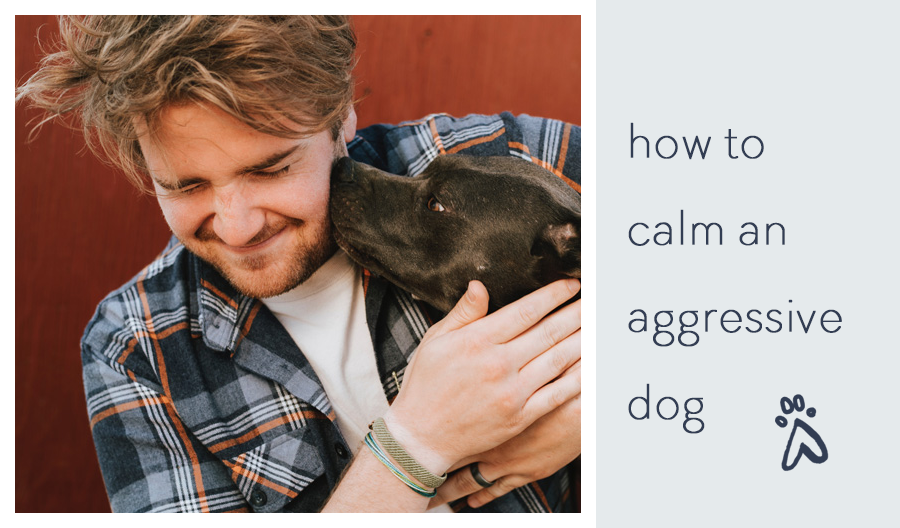
How to Calm an Aggressive Dog: Step-by-Step Guide
If your dog is aggressive on or off his leash and has started growling, snapping, trying to bite other people or animals, or demonstrating territorial aggression, then you could be facing a serious behavioral issue that requires your attention right away. Dog aggression is one of the main reasons that quality dog trainers are always in demand; as if it is not dealt with as soon as possible then it tends to only get worse. In spite of the unfair image that the media tends to paint whereby only certain larger breeds of dog are prone to aggression, the truth is that a crazed Chihuahua can be equally as much of a problem as a husky that weighs 100 pounds.
A dog that is already showing signs of aggression is not going to calm down overnight. However, that are several steps and tools that you can use to improve dog behavior problems and help him go back to enjoying life in all environments. As with any type of dog training, consistency is key. And any good professional dog trainer or animal behaviorist will tell you that you can attend, as many training sessions as you like to improve your dog’s behavior, but if you don’t keep the routine up at home outside of class, you simply won’t experience long-lasting results.
Why Do Dogs Become Aggressive?
Aggressive behavior in dogs is usually the result of fear, dominance, or a previous trauma that is being triggered by something in his current environment. And while it may seem to be an impossible and daunting task, eliminating signs of aggression in dogs and calming your dog down is easier than you think. Once you understand his triggers and how to manage his reactions, life is going to become a whole lot easier.
If your dog is exhibiting any of the following behaviors, then it’s time to get help before an accident happens:
- Stalking
- Stiffness
- Ears down and pointed tail
- Snarling
- Growling
- Lunging
- Staring
How to Identify the Triggers
Aggression is basically a behavioral reaction to a perceived threat. So, your first step in calming an aggressive dog down is to try and work out what is triggering your dog to act out. For example, if your dog only ever growls or snaps when he is eating, then he has food aggression. If he only snaps at other dogs when toys are around, then he is being possessive. The key is to notice the reaction as soon as it happens and swiftly correct it.
Canine aggression isn’t always directed at a person. Sometimes, dogs can become territorial or dominant around other dogs, which often mirror their physique and character. One could call this a clash of the titans! Many people find that their dogs go ballistic when they see a motorbike, a car, or a lawnmower. In this case, it is likely the loud noise that is triggering a fear-based aggressive response.
Regardless of the type of aggression that your dog is exhibiting, once you have identified the triggers, it’s time to put a plan of action together in order to diffuse any situation that you might encounter in the future and also help him accept his triggers as normality.
How to Calm an Aggressive Dog
Calming your dog’s angry temperament all comes down to you being vigilant and noticing when he is showing warning signs and then knowing what your next step is going to be. Below are a number of ways that you can manage your dog’s hostile attitude and restore balanced behavior. A dog that understands his boundaries and sees you as his pack leader is going to be a well-balanced, happy, and calm dog, which is what you should be aiming to achieve through implementing the advice in this article. If you find that you are not getting any results, then it could be time to call in a professional for further advice and help with regards to a training regime.
Visit the Vet
If your dog is normally as placid as can be, but all of a sudden is showing signs of aggression, then this could be due to an existing medical problem. You will want to rule out any serious illness by paying a visit to your vet and having your dog thoroughly examined for injury or even internal organ damage.
Schedule a Session with a Dog Trainer
Once your vet has ruled out any underlying medical issues, it might be time to consult a dog behaviorist to help discover the source of Fido’s newfound aggression. Not only can a trainer advise you further on how you should be managing any aggression or undesired behavior, but he will also be able to show you how to safely correct it without risking injury to yourself or your dog.
Implement a Plan
A professional trainer will be able to advise you on the best course of action for managing your dog’s aggression. Positive reinforcement training (where you reward positive behavior with treats) can be excellent, in some cases, especially when combined with vocal or physical correction techniques. Exposure therapy is also a great way to help your dog overcome their biggest fears. Let’s say that strange men are a massive trigger for your dog to act out, start by exposing him to strangers more often and each time you edge closer, reward him with a treat. The idea is that your dog will start to associate being around his fear or trigger with getting a tasty treat and will, therefore, start learning new, positive behaviors.
Don’t Yell at Your Dog
Punishing your dog through yelling or hitting him when he acts up has a tendency to backfire and if you send your dog into even more panic, the situation could escalate and someone could end up getting hurt. To instill calm in your dog, you need to be calm yourself, so yelling and screaming is going to be counterintuitive in this scenario. Dogs will give you warnings in the form of growling or cowering away from an uncomfortable situation and if you punish these warning signs, then the next time he feels anxious, he might just skip the warning stage and bite. If your pet ends up biting someone else, then you could face serious legal repercussions.
Look into Medications
In certain cases, training is just not enough to correct aggressive behavior. Some dogs may have been through a really tough time, especially if they came from a shelter, so aggression might be the only behavior they know. Trust is the foundation of any relationship and that includes the one with your dog, so he needs to learn that it is ok to be calm, especially when he is around you. An excellent natural solution to calming your dog is the use of CBD-infused dog treats or oil. CBD has been found to reduce dog aggression by diminishing and balancing out any anxiety that they might be experiencing. Your dog’s endocannabinoid system provides a bridge between his body and mind, so when CBD triggers the relevant receptors in his nervous system to physically calm him down, it will have an entourage effect on the mind.
Final Thoughts
If you are concerned about your ability to handle and eliminate your dog’s aggressive tendencies alone, then always seek professional help. The Internet is full of people’s opinions on medication and training methods, but not all of them are accurate or helpful. And finally, always know that with patience and practice most things in life have a habit of resolving themselves and when they do, the end result is often better than you could have ever imagined.
SOURCES:
This article by Jennifer is originally published at FOMO Bones.
Author bio: Jennifer is the voice behind the FOMO Bones blog. She's pretty sure in her past life, she was a Great Dane. However, we peg her as more of a labrador. Regardless of her breed, she's a dog enthusiast who has 15 years experience training dogs and owners.







Leave a comment
This site is protected by hCaptcha and the hCaptcha Privacy Policy and Terms of Service apply.